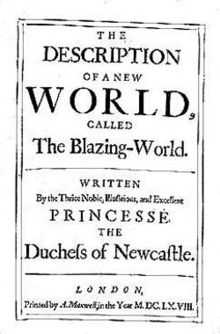The Blazing World

The Description of a New World, Called The Blazing-World, better known as The Blazing World, is a 1666 work of prose fiction by the English writer Margaret Cavendish, the Duchess of Newcastle. It has been mentioned as an early forerunner of science fiction.[1]
Story
As its full title suggests, Blazing World is a fanciful depiction of a satirical, utopian kingdom in another world (with different stars in the sky) that can be reached via the North Pole. It is "the only known work of utopian fiction by a woman in the 17th century, as well as one of the earliest examples of what we now call 'science fiction' — although it is also a romance, an adventure story, and even autobiography."[2]
A young woman enters this other world, becomes the empress of a society composed of various species of talking animals, and organizes an invasion back into her world complete with submarines towed by the "fish men" and the dropping of "fire stones" by the "bird men" to confound the enemies of her homeland, the Kingdom of Esfi.
The work was republished in 1668 with Cavendish's Observations upon Experimental Philosophy and thus functioned as an imaginative component to what was otherwise a reasoned endeavour in 17th century science.
Cavendish's book inspired a notable sonnet by her husband, William Cavendish, 1st Duke of Newcastle-upon-Tyne, which celebrates her imaginative powers. The sonnet was included in her book.
Influence
In Alan Moore's graphic novels chronicling the adventures of The League of Extraordinary Gentlemen, the Blazing World was identified as the self-same idyllic realm from which the extra-dimensional traveller Christian, a member of the first League led by Duke Prospero, had come in the late 1680s. The league disbanded when Christian returned to this realm, and it was to where Prospero, Caliban and Ariel also departed many years later.
In China Miéville's Un Lun Dun, a library book entitled A London Guide for the Blazing Worlders is mentioned, suggesting that travel between the two worlds is not all one-way.
In 2014, Siri Hustvedt published the novel The Blazing World, in which she describes Harriet Burden's brilliant but convoluted attempts at gaining recognition from the male-dominated NY art scene. Hustvedt has Burden refer to Margeret Cavendish as a rich source of inspiration at many occasions. Nearing the end of her life, Burden is comforted by Cavendish's work: "I am back to my blazing mother Margaret" (p.348), she writes in her notebook.
Notes
References
- Paper Bodies: a Margaret Cavendish reader. Ed. Sylvia Bowerbank and Sara Mendelson. Peterborough, Ont.: Broadview Press, 2000. ISBN 1-55111-173-X